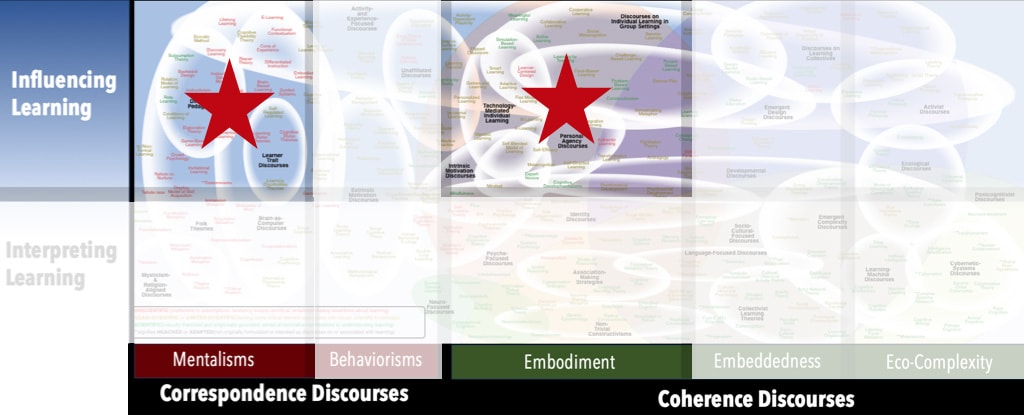Focus
Using adaptive software to offer targeted and tailored support for individualsPrincipal Metaphors
While Learner-Centered Design is explicit on the sources of its assertions, it does not specify or elaborate specific principles on the complex dynamics of learning. For the most part, metaphors of learning are quite varied, but the Attainment Metaphor appears to be most frequently invoked:- Knowledge is … a territory/area/domain/field
- Knowing is … attaining a goal
- Learner is … a seeker (individual)
- Learning is … journeying (arriving at, reaching, progressing, accomplishing, achieving)
- Teaching is … guiding, facilitating, supporting
Originated
1990sSynopsis
Learner-Centered Design pulls together principles from Socio-Cultural Theory (e.g., scaffolding), Blended Learning (combining face-to-face and technology-mediated modes), Constructionism (e.g., focused on creating something), and Learning Styles Theories (e.g., attending to individual differences and preferences). Learner-Centered Design is most often concerned with creating adaptive software to support learners in ways that are simultaneously tailored to group activity and targeted to specific individual needs. Associated constructs include:- Low Floor – High Ceiling (Low Threshold – High Ceiling; LTHC) (Seymour Papert, 1970s) – a descriptive label for learning tasks that combine Variable Entry (see below) and Open Ended (see below)
- Open Ended – a descriptive label for learning tasks that can be elaborated or extended to different levels of sophistication, depending on learners’ interests and capacities
- Variable Entry – a descriptive label for learning tasks that are accessible to students across ranges of ability and background knowledge
Commentary
Learner-Centered Design is a mash-up – and an uncritical one. It combines instructional principles from theories that are incompatible and, sometimes, contradictory. In doing so, it offers a blend that has a popular appeal, but that is indefensible theoretically. That’s not to say it’s a bad idea: using adaptive software to monitor and respond to specific learner needs is a good idea. However, it is diminished by being wrapped in a hodge-podge of notions.Authors and/or Prominent Influences
Elliot Soloway; Mark Guzdian; Kenneth E. HayStatus as a Theory of Learning
Learner-Centered Design is not a theory of learning.Status as a Theory of Teaching
Learner-Centered Design is about influencing learning, so it is properly construed as a theory of teaching – or, perhaps more appropriately, a mash-up of teaching theories.Status as a Scientific Theory
Learner-Centered Design fails to meet any of our criteria for a scientific theory.Subdiscourses:
- Low Floor – High Ceiling (Low Threshold – High Ceiling; LTHC)
- Open Ended
- Variable Entry
Map Location

Please cite this article as:
Davis, B., & Francis, K. (2023). “Learner-Centered Design” in Discourses on Learning in Education. https://learningdiscourses.com.
⇦ Back to Map
⇦ Back to List
